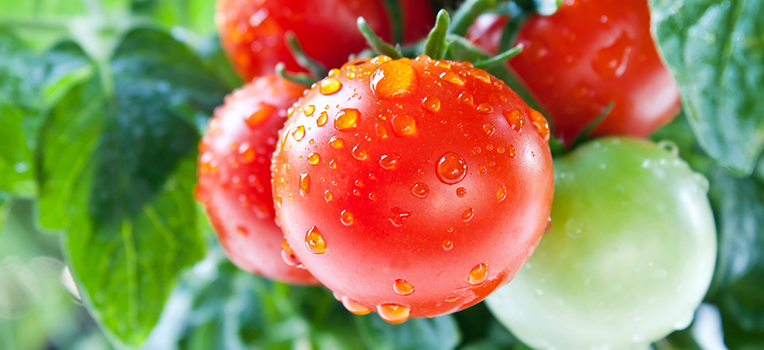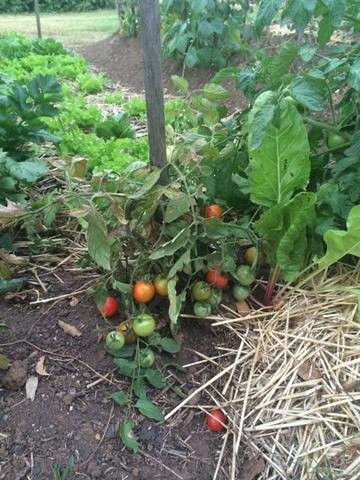Preparing To Plant
Choose an open position for your tomatoes that receives at least six hours of full sun each day.
Tomatoes grow happily in most soils but, like all plants, a little time spent on their soil will go a long way to healthy plants and an abundance of fruit. If you have clay soil (like many areas of Sydney), it’s best to raise the planting area to help with drainage. Add compost to help with soil structure, Dolomite to prevent blossom end rot (calcium deficiency) and a Tomato and Vegetable Food around one week before you plant your tomatoes and water in well.
If you grew tomatoes last year, it’s best to choose a new spot for your plants this year to eliminate any risk of soil borne disease. Plants can be returned to the same location the following year – though the longer the better.
If you’re planning to plant in a pot, choose a good quality Tomato and Vegie growing mix to plant them into.
Choosing Your Variety
There are a huge number of varieties available, with differences in growing habit and the size, shape, taste, colour and acidity of fruit. Here some of our favourites that we grow at Flower Power:
Small Fruit Varieties
Cherry Cocktail: This early maturing variety produces large clusters of sweet, bite-sized cocktail fruit.
Grape: A very heavy yielding variety producing long clusters of sweet fruit.
Lady Bug: A sweet cherry tomato producing lots of 10-cent piece sized fruit.
Orange Pixie: A sweet tasting dwarf variety producing masses of large cherry tomatoes. Perfect for pots.
Sugar Snack: A small, cherry sized fruit with a sweet full flavour.
Sweet Bite: Smaller than traditional cherry varieties, this early maturing variety produces hundreds of juicy, bite-size fruit.
Tiny Tim: Produces sweet cherry sized fruit on a dwarf bush – perfect for pots.
Tommy Toe: Super sweet, bit- sized balls of fruit that produces hundreds of 50-cent piece sized tomatoes.
Medium to Large Fruit Varieties
Apollo: Produces high yields of full flavoured, round, red fruit early in the season.
Big Bite: An extra-large, full flavoured beefsteak type tomato.
Black Krim: An heirloom Russian variety from the 19th century with a full flavoured, slightly flattened fruit.
Grosse Lisse: Medium to large deep red fruit mid to late in the season.
Health Kick: A delicious plum variety containing 55% more antioxidants.
Oxheart: Originating in Hungary, this old-fashioned favourite has fine, feathery foliage and heart-shaped pink fruit with meaty flesh. An heirloom variety perfect for sandwiches.
Patio Supreme: Early to mature with full flavoured bright red, flat fruit on a compact, dwarf bush – perfect for pots.
Roma: Rich red medium to large egg-shaped, full flavoured fruit mid to late in the season.
Totem: A delicious truss bush variety with medium sized red fruit, perfect for pots.
Truss: Truss tomatoes are sweet, juicy and easy to roast . They can be grown in-ground or in a large pot and need a stake to climb.
Planting & Growing
When you’re ready to plant, place your seedlings about 70cm apart. This may seem like a lot while they are this size, but any less and they’ll be crowded when they grow. Your plants will need support as they go, so put in a hardwood stake around 5cm from the plant, or try a tomato cage. Mulch the plants well, preferably with an organic mulch like Sugar Cane that will add nutrients back to the soil as it breaks down. Mulch should be applied 5cm thick with a 5cm gap around stems to prevent collar rot.
As the plant grows, choose two main stems and tie them to the stake at 30cm intervals as they grow. Once these two stems are established all other side shoots (laterals) should be pinched out to keep the plant tidy and manageable, as well as helping the plant concentrate on fruit production. Stems should be pinched off once a week as they can get wild very quickly!
Feeding
To get the most out of your tomato plants, it’s best to keep them well fed. Use the Tomato and Vegie fertiliser that you added to the soil prior to planting to feed them once a month as per the pack instructions, commencing when your plants first start flowering.
If your plants seem to be fattening up with leaves instead of fruit, try adding potash to encourage flowers and fruit.
Watering
Tomatoes require lots of water and regularly. Drying out will drastically reduce their yield, and irregular watering leads to blossom rot – a sunken black patch on the bottom of your fruit. Water your plants weekly, and once fruit has developed try to water daily during very hot weather. Try to avoid overhead watering as this can encourage leaf blight and other fungal diseases.
Pest Control
Tomatoes are as popular with pests as they are with people, but it’s easy to protect your crop. Here are some pests and diseases to look out for.
Caterpillars: Will eat holes in your leaves and green fruit. Pick off if it’s only a small problem or spray with Dipel or Success Ultra to protect your plants.
Fruit Fly: Will lay eggs in your ripening fruit – ugh! Try Eco-Naturalure or hang fruit fly bait traps near your plants.
Aphids: These rascals suck sap from foliage and spread plant disease. Check your plants for ants – ants are themselves harmless, but come to feed on the sticky residue left by aphids and white fly so are a sign of an aphid problem. Spray with Conquer, or try to encourage the aphids natural enemy to take up residence – the lady beetle.
Tomato wilt: If this disease has set in all the leaves will wilt and the plant will appear very dry. What’s happening is the stem inside is dying and unfortunately the plant can’t be saved. This will happen if you don’t keep aphids under control so prevention is the best cure!
Early blight: If you notice tomato leaf spots and yellowing lower leaves you may have tomato early blight. This disease causes damage to the leaves, stems and even the fruit of the plant. Treat with Yates Liquid Copper Fungicide.
Blossom end rot – bottom of the tomato fruit will discolour and rot. This is a sign of calcium deficiency. You can try to add Dolomite at this stage but it’s likely to late.
Companion Planting: For a completely organic approach, try planting basil and/or marigolds with your tomatoes – they can help to deter aphids, white fly and nematodes (a disease affecting roots).
Harvesting
You’ve successfully grown your first tomato, and now it’s time to enjoy it!
Pick your tomato when it is red-ripe. As pretty as they look, leaving your fruit on the vine too long will cause it to lose its sweetness and become floury.

